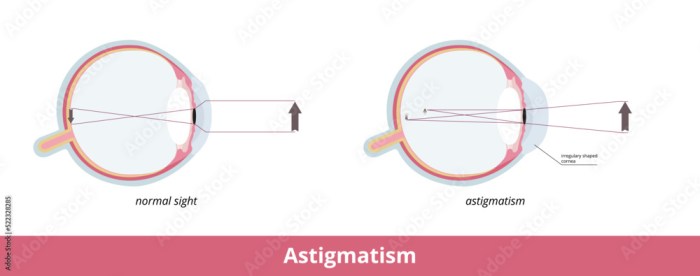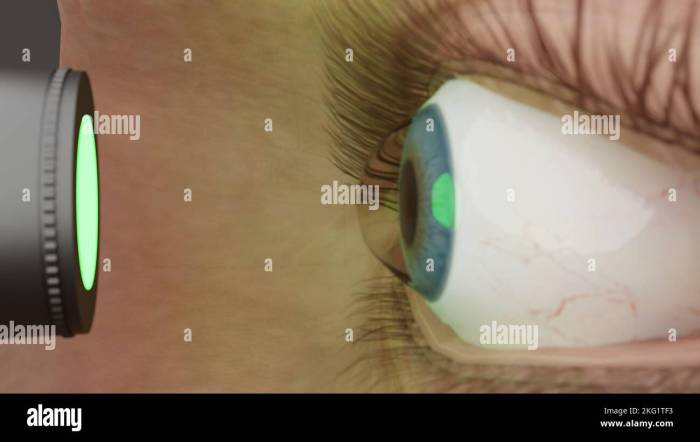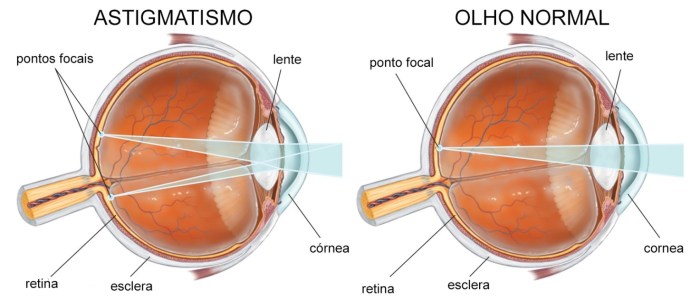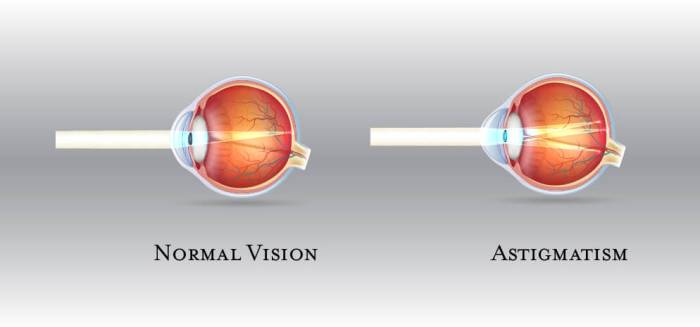Malcurvature of the cornea leading to blurred vision is – Malcurvature of the cornea, a condition that distorts the curvature of the cornea, is a prevalent cause of blurred vision. This distortion affects the eye’s ability to focus light accurately on the retina, leading to a range of visual disturbances.
Understanding the causes and symptoms of malcurvature of the cornea is crucial for proper diagnosis and effective management. This article delves into the intricacies of this condition, exploring its impact on vision and the various treatment options available.
Definition of Malcurvature of the Cornea

Malcurvature of the cornea, also known as corneal astigmatism, refers to an irregularity in the curvature of the cornea, the clear outer layer of the eye that covers the pupil and iris. This irregularity prevents light from focusing properly on the retina, resulting in blurred or distorted vision.
The causes of malcurvature of the cornea can be genetic or acquired. Genetic factors can lead to corneal irregularities from birth, while acquired causes may include eye injuries, infections, or certain medical conditions that affect the shape of the cornea.
There are different types of malcurvature of the cornea, depending on the shape and orientation of the irregularity. These include regular astigmatism, where the cornea has a more oval shape, and irregular astigmatism, where the cornea has a more complex shape.
Symptoms of Malcurvature of the Cornea
The most common symptom of malcurvature of the cornea is blurred or distorted vision, especially at a distance. Other symptoms may include:
- Eyestrain and headaches
- Double vision
- Glare and halos around lights
- Difficulty seeing at night
Malcurvature of the cornea can also lead to other eye problems, such as dry eye syndrome and keratoconus, a condition where the cornea becomes thin and cone-shaped.
Diagnosis of Malcurvature of the Cornea: Malcurvature Of The Cornea Leading To Blurred Vision Is

Malcurvature of the cornea is diagnosed through a comprehensive eye exam. During the exam, the eye doctor will use various tests to assess the shape and curvature of the cornea, including:
- Retinoscopy
- Corneal topography
- Aberrometry
These tests provide detailed information about the curvature of the cornea and help the eye doctor determine the severity and type of malcurvature present.
Treatment Options for Malcurvature of the Cornea
The treatment options for malcurvature of the cornea depend on the severity of the condition. Mild cases may not require treatment, while more severe cases may require corrective lenses or surgery.
Corrective Lenses:Eyeglasses or contact lenses can be used to correct the refractive errors caused by malcurvature of the cornea. Toric lenses, which are specially designed for astigmatism, are often used to provide clear vision.
Surgery:Surgical procedures, such as laser-assisted in situ keratomileusis (LASIK) or photorefractive keratectomy (PRK), can be used to reshape the cornea and correct malcurvature. These procedures are typically used for more severe cases of astigmatism.
Management of Malcurvature of the Cornea

Managing malcurvature of the cornea involves regular eye exams to monitor the condition and ensure that the treatment is effective. Follow-up exams are important to detect any changes in the curvature of the cornea or the development of other eye problems.
In some cases, lifestyle changes may also be recommended to manage malcurvature of the cornea. These changes may include avoiding eye rubbing, wearing protective eyewear when appropriate, and using artificial tears to keep the eyes moist.
Prevention of Malcurvature of the Cornea

While some cases of malcurvature of the cornea are caused by genetic factors, there are steps that can be taken to reduce the risk of developing the condition. These steps include:
- Protecting the eyes from injury
- Managing underlying medical conditions that can affect the cornea
- Getting regular eye exams to detect and treat any eye problems early on
By following these preventive measures, individuals can help reduce their risk of developing malcurvature of the cornea and maintain good eye health.
FAQ Section
What are the common symptoms of malcurvature of the cornea?
Blurred vision, halos or starbursts around lights, double vision, and difficulty seeing at night are common symptoms.
Can malcurvature of the cornea be prevented?
While some causes of malcurvature cannot be prevented, regular eye exams and proper eye care can help detect and manage the condition early on.
What are the treatment options for malcurvature of the cornea?
Treatment options include eyeglasses or contact lenses for mild cases, and surgical procedures such as corneal transplantation or refractive surgery for more severe cases.